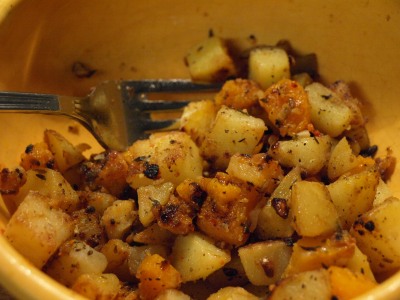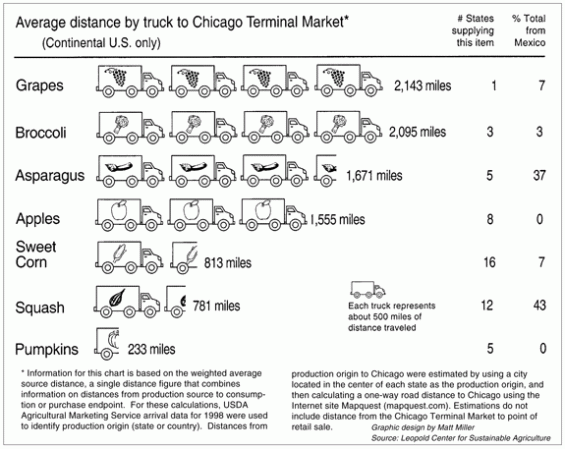I challenged myself to eat locally for one week. Because local does not have one set definition, I defined local as grown or raised under 150 miles, with the exception of bread, which I ate if it was produced in Madison. With these guidelines in mind, the challenge began.
Eating food from a regular grocery store, restaurants, and campus dining halls was immediately out of the question. I went to the farmers market and Willy Street Coop which has a fair amount of local options and also signs saying where all their produce comes from. Interestingly, even at the farmers market there is no guarantee of local food, because there are not regulations on where the farmers can come from. However, it still mostly is. Some farmers are from Eau Claire, WI, which is about 200 miles away –significantly farther than a backyard garden, but a vast improvement from 1,500 miles, the average distance produce comes from in the United States.
During this week I did almost all my own cooking. I live in the residence halls, but I could eat nothing at any of the cafeterias, except for milk and the bagels they have, which are from a Madison company. I ate locally produced bread because locally grown and milled wheat is not available here. Ideally, I wouldn’t have eaten bread or wheat at all, but for reasons of practicality (and fears of being hungry the entire week ), I decided to compromise. It’s not that I don’t know how to go a week without eating bread, but just that most of the other “staple foods” were also cut out of my diet; I couldn’t eat rice, processed corn, pasta, or quinoa. I ate mostly vegetables, dairy, and eggs. I should add that I’m vegetarian, but if I were not I know there are a lot of local meat options available here.
All processed or multi-ingredient food was excluded for the week. For example, take strawberry yogurt, and for the sake of the example, lets say it’s made by a local yogurt company who claims to get there milk from Wisconsin cows. That’s great, but what about the other ingredients? The strawberries could be local, but it is very unlikely because the company would probably source from a bigger, cheaper strawberry market, such as California. The sugar would be made from beets, sugar cane, or corn. The beets or corn could be local in theory, but since sugar is a processed ingredient, even if they were grown here they would have needed to be shipped to a processing plant and then shipped back. It becomes very complicated and this isn’t even to mention all the other additives and preservatives that would be in the yogurt. Not only is it unlikely that the ingredients are local, but it is also very difficult to find out where they actually are from.
I typically ate an egg or bread with honey for breakfast. For lunch I would make a cheese, lettuce and tomato sandwich or a salad. Dinner was a variety of things. I made a kale and carrot stir fry, baked butternut squash and potatoes (see picture below) scrambled eggs, among other dishes.
Although eating locally did require a lot of cooking, this is just because how our food systems are currently set up. To exemplify the actual abundance and variety of food growing in are area, here is a list compiled by the Dane County Farmers Market of what they report to have available each month of the year:
April & May
Asparagus, Bakery goods, Bedding plants, Bunch onions, Cheese, Cut flowers, Dry beans, Greenhouse cucumbers and tomatoes, Hanging baskets, Lettuce, Maple syrup, Meats, Morel mushrooms, Perennial plants, Rhubarb, Spinach, Other specialty items
June
Asparagus, Baby carrots, Beets, Broccoli, Cauliflower, Cucumbers, Greenhouse cucumbers and tomatoes, Kohlrabi, Lettuce, Maple syrup, Peas, Rhubarb, Salad greens, Strawberries, Zucchini
July
Apples, Baby Carrots, Beets, Broad Beans, Broccoli, Cabbage, Cauliflower, Cherries, Cucumbers, Currants, Dill, Eggplant, Gooseberries, Green and yellow beans, Greenhouse cucumbers and tomatoes, Honey, Kohlrabi, Lettuce, Maple syrup, Okra, Peas (Sugar, Snap and Snow), Pesto, Potatoes, Raspberries, Rhubarb, Salad greens, Strawberries, Summer squash, Swiss chard, Tomatoes (Cherry, Beefsteak), Zucchini
August
Apples, Artichokes, Baby carrots, Beets, Broad beans, Broccoli, Brussel sprouts, Cabbage, Carrots, Cauliflower, Celeriac, Celery, Cherries, Cucumbers, Dill, Dried flowers, Edible gourds, Eggplant, Flowers, French shallots, Garlic, Green and yellow beans, Greenhouse cucumbers and tomatoes, Herbs, Honey, Kale, Kohlrabi, Leeks, Lettuce, Maple syrup, Melons, Okra, Onions, Parsley, Parsnips, Pears, Plums, Potatoes, Peas (Sugar, Snap, Snow), Peppers, Pesto, Rhubarb, Rutabagas, Salad mix, Strawberries, Summer squash, Sweet corn, Swiss chard, Tomatoes (Cherry, Beefsteak), Wild mushrooms, Winter squash, Zucchini
September, October, November
Apples, Artichokes, Beets, Broad beans, Broccoli, Brussel sprouts, Cabbage, Carrots, Cauliflower, Celeriac, Celery, Cucumbers, Dill, Dried flowers, Edible gourds, Eggplant, Flowers, French shallots, Garlic, Gourds, Grapes, Green and yellow beans, Herbs, Honey, Indian corn, Kale, Kohlrabi, Leeks, Lettuce, Maple syrup, Melons, Okra, Onions, Parsley, Parsnips, Pears, Peppers, Pesto, Plums, Potatoes, Rutabagas, Salad mix, Strawberries, Summer squash, Sweet corn, Swiss chard, Tomatoes (Cherry, Beefsteak), Wild mushrooms, Winter squash, Zucchini
Even in winter, along with animal products, they still report having chard, kale, lettuce, radish, spinach and tomatoes, products which are presumably greenhouse grown.
The following is a list of resources for eating locally in Madison.
This website is where the above list of foods came from. There are also recipes, tips for eating seasonally, and food preservation instructions. http://www.dcfm.org/shopmkt.asp#prodo
Slow Food is an international organization supporting “good, clean, fair” food. UW-Madison has a chapter with offers dinner Monday night and lunch on Wednesdays. They also sell Growing Power’s Market Baskets of fresh produce. http://slowfooduw.org/
The Madison Area Community Supports Agriculture Coalition is an organization that connects farmers with consumers who pledge to support the farmer by purchasing a weekly box of produce. Their goal is to “support a sustainable agriculture system which provides farmers with direct outlets for farm products and ensures fair compensation.” http://www.csacoalition.org/
F.H. King is a student run UW-Madison farm. Among other things, they handout their produce for free to students from June-October, which would be great way to get local produce. http://fhkingstudentfarm.com/
These resources all provide ways to get local food at a reasonable cost. For example it’s five dollars for dinner at Slow Food, free for F.H King produce, and items at the farmers market are usually very reasonably priced, especially the vegetables that farmers have an overabundance of.
After considering the list of produce, all these resources, and experiencing eating completely locally in Madison, I have concluded that with a shift in the food system, our diets could shift to almost completely local food, still having diverse and healthy diets. They would be different diets, but by no means worse. In fact, the week I ate locally was probably the healthiest week for me in terms of food since I’ve been at school, since I was eating all whole foods and cooking them myself. It was a successful challenge, a good experience, and one that will become easier as the food systems continues to shift towards local food.


